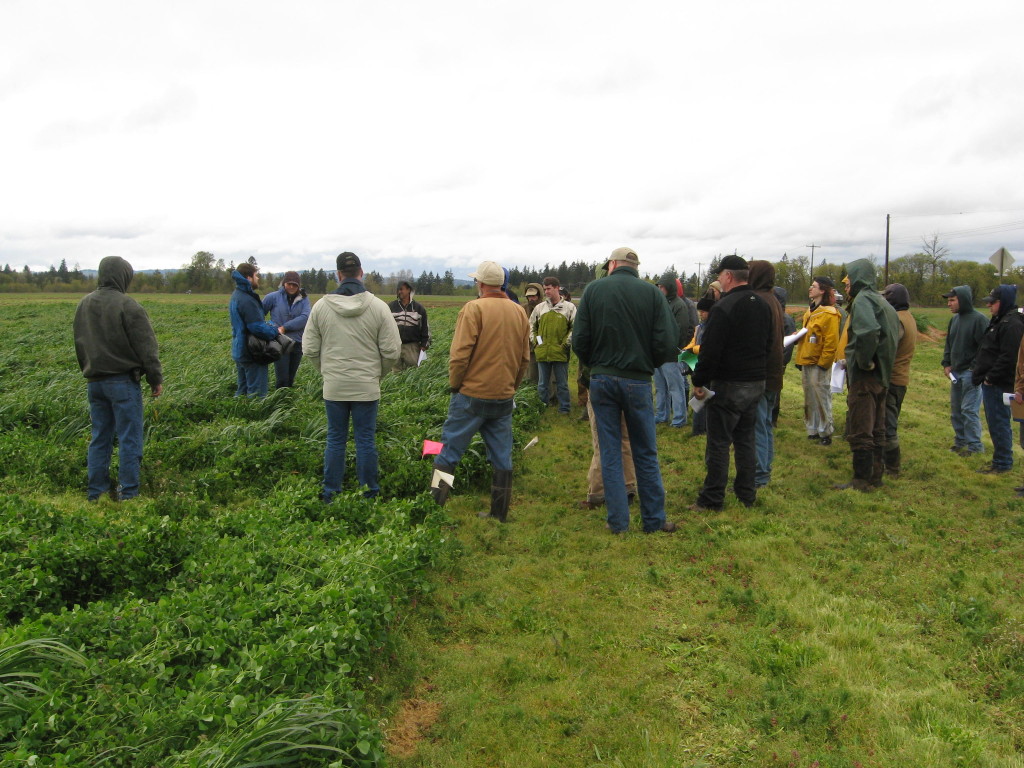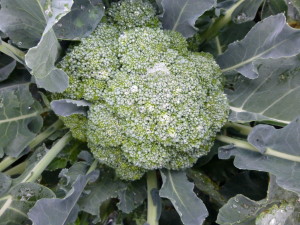
Stories from the Field: Calculating the Impact of Sustainable Farming Research
Since its inception over 25 years ago, the Sustainable Agriculture Research and Education (SARE) program has led the way in farmer-driven, innovative agriculture research. SARE’s unique research focus on cutting edge, farmer-driven innovations has empowered thousands of farmers to utilize cover crops in order to slow erosion, improve soil health, enhance water conservation, control pests and diseases, and increase biodiversity. Although cover crops have been used by farmers since ancient times, they remained a niche practice until relatively recently when renewed interest in soil health and biological nitrogen fixation stimulated interest. Today, cover crops are quickly becoming a widely used conservation practice on farms of all types and sizes across the country.
Quantifying the Benefits of Cover Crops
As more farmers began to turn to cover crops, Nick Andrews, a Small Farms Extension Agent at Oregon State University (OSU) and Dan Sullivan (OSU Soil Scientist), realized that many farmers were unable to accurately quantify the benefits of their cover cropping practices. In 2010, OSU received a Professional + Producer grant from Western SARE to address this problem. They used the grant to develop the OSU Organic Fertilizer and Organic Cover Crop Calculator, which allows farmers to quantify how much nitrogen their cover crops are adding to their soils.
“The farmers we work with were interested in simple, but reasonably accurate methods for estimating nitrogen release from legume cover crops,” said Andrews. “The inspiration for the proposal came out of my Extension work trying to solve problems that individual farmers were facing.”
To quantify the benefits of cover cropping, on-farm trials and trials at OSU’s North Willamette Research and Extension Center measured nitrogen release from cover crops and organic fertilizers in the field. Lab studies provided more accurate information on nitrogen release that was used develop a nitrogen mineralization model growers could use.
The SARE grant allowed OSU to work closely with several farmers who were successfully using cover crops in their crop rotations. David Brown of Mustard Seed Farms, Jim Bronec of Praying Mantis Farm, Scott Latham of Sauvie Island Organics and other farmers worked with Andrews to measure the amount of plant-available nitrogen mineralized from their cover crops, and compared it to effects of organic fertilizers. Like most farmers who had successfully grown cover crops for years, they could grow large cover crops, but did not yet know how much nitrogen they were adding to their soil.
By providing farmers with this information, the calculator allows them to save money on fertilizers and understand the true value of their legume cover crops. OSU estimates the economic impact of the calculator to be as much as $2 million per year from a combination of cost savings and improved nutrient management.
“We found that farmers were consistently underestimating the nitrogen value of their cover crops,” explained Andrews. “The calculator allows them to develop more accurate nutrient management programs. Tualatin Soil & Water Conservation District and other local districts encourage growers to use the calculator to develop organic nutrient management plans. Legume cover crops are a cheaper nitrogen source than most Organic fertilizers. Growers can also enter requirements for other nutrients and quickly identify the lowest cost organic fertilizer program.”
Since the completion of the SARE project in 2012, the calculator has helped growers in Oregon and attracted interest in other states. SARE prides itself on its ability to provide farmers with easily accessible, regionally specific information that they can use to benefit their own operations. In order to facilitate this flow of knowledge, one important requirement of those who receive SARE grants is to make the results of their research projects available to Extension agents, NRCS staff, students, farmers, and others who may benefit from access to research results.
The calculator, which is designed for western Oregon farmers, has also been adapted for other regions. Amber Moore at the University of Idaho developed a similar calculator for irrigated fields in semi-arid areas. Koon-Hui Wang and Ted Radovich from the University of Hawaii are developing a similar grower-friendly tool for tropical climates. Agriculture educators also use the cover crop calculator as a teaching tool for students.
“The calculator has been online since 2011 and it has been encouraging because we still hear from farmers, professors, and student groups asking about it. Farmers across the Pacific Northwest are using it, but we have also heard from people in Idaho, Florida, North Carolina, California and elsewhere,” explains Andrews. “The grant helped us study challenges David Brown, Jim Bronec and other farmers identified, and it is great to see such widespread interest.”
Predicting crops in a changing climate
After the success of the cover crop calculator, Andrews, Len Coop of the OSU Integrated Plant Protection Center, and other OSU colleagues applied for an additional Western SARE grant to address another common issue farmers face – vegetable crop planning.
“When you look in a seed catalog, the descriptions of vegetable varieties typically tell you how many days to maturity. Depending on what time of year you plant and your region or climate, these estimates are often inaccurate,” explained Andrews. “It is important for farmers to know when their crop is going to be mature so that they can fulfill their contracts, plan their business, prevent gaps in crop availability, and reduce food waste.”
Hoping to improve on calendar days, Andrews and his team are developing the Croptime website that uses Degree-Day Models to predict maturity. Orchardists have used these sorts of models to manage insect and disease pests for more than 20 years. Degree-Day Models use time and temperature to predict crop development.
“I was working with David Brown of Mustard Seed Farms again – he had created Degree-Day Models on his own farm,” said Andrews. “He taught himself to do it on his own and was using his models to accurately plan his broccoli plantings. I was impressed and started discussing the concept with other farmers.”

Several small and mid-sized farmers were very interested in the models, so OSU developed the Croptime proposal and received a Western SARE Research and Education grant in 2012.
Since then, OSU has been developing Degree-Day Models for popular varieties of 15 different vegetable crops, as well as three weed species. By predicting when weeds will go to seed, organic farmers can be better prepared to control weeds before they have the chance to spread seeds that will return as weeds the next year.
“If the climate continues to change and extreme weather becomes more common, we hope this tool will help farmers adapt their cropping schedules and variety selections more quickly.”
Croptime is online now with the first 14 models available for broccoli and cucumber varieties, hairy nightshade, lambsquarter and redroot pigweed. They plan to launch another 40 vegetable variety models by spring 2017. OSU is teaching farmers in Washington and Oregon to use the site. They are also beginning to partner with students in undergraduate classes at Evergreen State College, Oregon State University and Clackamas Community College to collect data and develop models for more crop varieties grown in the region.
The Croptime site links to more than 15,000 automatic weather stations across the country. Although growers in different states can use the models, the OSU team recommends caution, because Degree-Day Models developed in Western Oregon may not hold up well in different climates. OSU continues to develop Degree-Day Models for additional crop varieties and would be interested in talking to other farmers and researchers with similar interests.
“Thanks to the SARE funding we were able to generate new research based information to address real challenges faced by local, organic and sustainable family farms,” said Andrews. “We have also been able to develop online decision-tools that growers, agriculture students and agricultural professionals can use to make site-specific nutrient management and crop scheduling decisions,” said Andrews.
The Future of SARE Research Funding
Increased investment in sustainable agricultural research is vital to continued productivity and innovation in American agriculture. SARE has been at the forefront of research and extension activities that develop profitable, environmentally sound, and resilient farming systems.
In addition to serving Oregon farmers as an extension agent, Andrews is an Oregon SARE State Co-Coordinator with Maud Powell of the OSU Southern Oregon Research and Extension Center. Andrews has this to say about the value of the program:
“SARE has always focused on their work on research and education that is very relevant to farmers,” said Andrews. “The program is managed by Advisory Councils that include leading innovative farmers in each region who make sure that the projects are relevant and useful. SARE also helps land-grant university and other governmental and [non-governmental organizations] create positive change in society, by improving the environmental and economic resilience of family farms, steward natural resources, and develop food and farming systems that can thrive on an increasingly crowded planet.”
Despite SARE’s popularity and productivity, however, it is still not funded at even half of its authorized amount. NSAC urges Congress to match the Administration’s budget request to fund SARE at $30 million in Fiscal Year 2017, which would bring the funding to just half of the authorized spending level.

